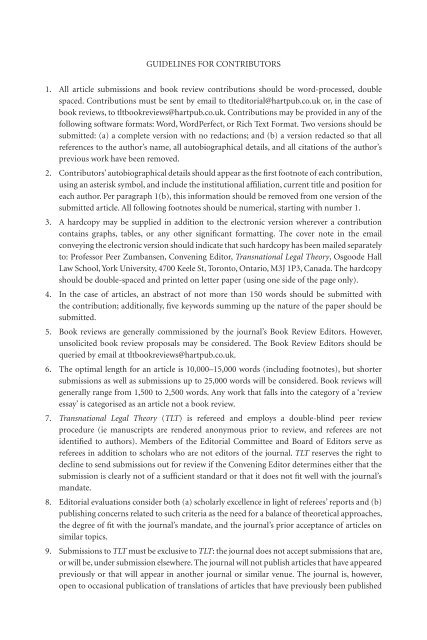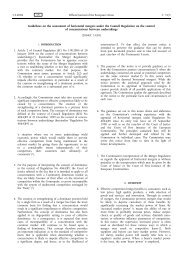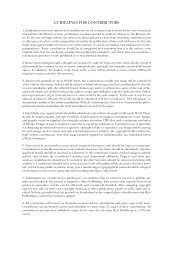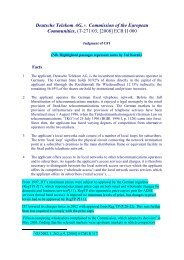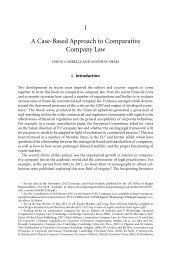GUIDELINES FOR CONTRIBUTORS 1. All article ... - Hart Publishing
GUIDELINES FOR CONTRIBUTORS 1. All article ... - Hart Publishing
GUIDELINES FOR CONTRIBUTORS 1. All article ... - Hart Publishing
You also want an ePaper? Increase the reach of your titles
YUMPU automatically turns print PDFs into web optimized ePapers that Google loves.
<strong>GUIDELINES</strong> <strong>FOR</strong> <strong>CONTRIBUTORS</strong><br />
<strong>1.</strong> <strong>All</strong> <strong>article</strong> submissions and book review contributions should be word-processed, double<br />
spaced. Contributions must be sent by email to tlteditorial@hartpub.co.uk or, in the case of<br />
book reviews, to tltbookreviews@hartpub.co.uk. Contributions may be provided in any of the<br />
following software formats: Word, WordPerfect, or Rich Text Format. Two versions should be<br />
submitted: (a) a complete version with no redactions; and (b) a version redacted so that all<br />
references to the author’s name, all autobiographical details, and all citations of the author’s<br />
previous work have been removed.<br />
2. Contributors’ autobiographical details should appear as the first footnote of each contribution,<br />
using an asterisk symbol, and include the institutional affiliation, current title and position for<br />
each author. Per paragraph 1(b), this information should be removed from one version of the<br />
submitted <strong>article</strong>. <strong>All</strong> following footnotes should be numerical, starting with number <strong>1.</strong><br />
3. A hardcopy may be supplied in addition to the electronic version wherever a contribution<br />
contains graphs, tables, or any other significant formatting. The cover note in the email<br />
conveying the electronic version should indicate that such hardcopy has been mailed separately<br />
to: Professor Peer Zumbansen, Convening Editor, Transnational Legal Theory, Osgoode Hall<br />
Law School, York University, 4700 Keele St, Toronto, Ontario, M3J 1P3, Canada. The hardcopy<br />
should be double-spaced and printed on letter paper (using one side of the page only).<br />
4. In the case of <strong>article</strong>s, an abstract of not more than 150 words should be submitted with<br />
the contribution; additionally, five keywords summing up the nature of the paper should be<br />
submitted.<br />
5. Book reviews are generally commissioned by the journal’s Book Review Editors. However,<br />
unsolicited book review proposals may be considered. The Book Review Editors should be<br />
queried by email at tltbookreviews@hartpub.co.uk.<br />
6. The optimal length for an <strong>article</strong> is 10,000–15,000 words (including footnotes), but shorter<br />
submissions as well as submissions up to 25,000 words will be considered. Book reviews will<br />
generally range from 1,500 to 2,500 words. Any work that falls into the category of a ‘review<br />
essay’ is categorised as an <strong>article</strong> not a book review.<br />
7. Transnational Legal Theory (TLT) is refereed and employs a double-blind peer review<br />
procedure (ie manuscripts are rendered anonymous prior to review, and referees are not<br />
identified to authors). Members of the Editorial Committee and Board of Editors serve as<br />
referees in addition to scholars who are not editors of the journal. TLT reserves the right to<br />
decline to send submissions out for review if the Convening Editor determines either that the<br />
submission is clearly not of a sufficient standard or that it does not fit well with the journal’s<br />
mandate.<br />
8. Editorial evaluations consider both (a) scholarly excellence in light of referees’ reports and (b)<br />
publishing concerns related to such criteria as the need for a balance of theoretical approaches,<br />
the degree of fit with the journal’s mandate, and the journal’s prior acceptance of <strong>article</strong>s on<br />
similar topics.<br />
9. Submissions to TLT must be exclusive to TLT: the journal does not accept submissions that are,<br />
or will be, under submission elsewhere. The journal will not publish <strong>article</strong>s that have appeared<br />
previously or that will appear in another journal or similar venue. The journal is, however,<br />
open to occasional publication of translations of <strong>article</strong>s that have previously been published
only in a language other than English and which the editors determine are significant <strong>article</strong>s<br />
deserving of wider readership.<br />
10. Ordinarily, TLT responds with its decision on acceptance or non-acceptance within 8 weeks.<br />
1<strong>1.</strong> The Author warrants to <strong>Hart</strong> <strong>Publishing</strong> (‘the Publisher’) that the Contribution does not in any<br />
way infringe an existing copyright, or confidence or any proprietary or other actionable rights<br />
and that all reasonable precautions have been taken or will be taken to ensure that it contains<br />
no libellous, defamatory or obscene material of an actionable character and that publication<br />
of any information in the Contribution obtained while in the service of the Crown will not<br />
contravene the Official Secrets Acts and that the Author is entitled as owner or prospective<br />
owner of the copyright to authorise publication.<br />
12. Copyright remains with the Author, subject to the following contractual conditions: (a) once<br />
the Contribution has been published, the Author may not publish the same or substantially<br />
the same work as published in TLT in any other journal or like context (eg a working paper<br />
series); (b) the Author may use their Contribution only in book publications jointly or solely<br />
authored by them or edited by them, provided that TLT is acknowledged as the original<br />
place of publication and the Publisher is notified in writing in advance; (c) for use of the<br />
Contribution in any other venue, such as an anthology not edited by the Author, the Publisher<br />
must give its agreement; (d) the Author shall honour conditions set out in the next paragraph<br />
with respect to circulation of PDFs of the Contribution; and (e), as a condition of publication,<br />
the Author grants an exclusive licence to the Publisher to publish in all forms, whether<br />
hardcopy or electronic, and further grants a corresponding licence permitting the Publisher to<br />
administer all rights and permissions (ie grant sub-licences to third parties) in relation to the<br />
Contribution. Any income derived by the Publisher from licences or sub-licences remains with<br />
the Publisher.<br />
13. The Author will receive an offprint of their Contribution in PDF form, which PDF may be<br />
circulated by the Author to selected colleagues (wherever located). The Author may also use<br />
their own Contribution freely in their own teaching, including providing students in their<br />
classes with PDFs of the Contribution. The PDFs may not be posted online other than on<br />
a password-protected web page used solely by the Author themselves for teaching purposes.<br />
The contract between the Publisher and the Author will indicate a date after which the<br />
Contribution may be posted online, subject to specific conditions. The Author may order hard<br />
copy offprints of their Contribution, in advance of their Contribution going to press, for a fee.<br />
14. For any questions not answered above, send queries to tlteditorial@hartpub.co.uk.<br />
* * *<br />
House style<br />
Except where specifically noted below, the house style follows the Oxford Standard Citation for<br />
Legal Authorities (OSCOLA). OSCOLA can be downloaded at www.law.ox.ac.uk/publications/<br />
oscola.php. While OSCOLA is not a style guide, the introduction to it includes a few recommended<br />
texts that will prove useful to contributors.<br />
Spelling<br />
• Standard UK spelling: ‘-ise’ / ‘-isation’ / ‘-ising’. ‘z’ should remain when quoting sources.<br />
• Use UK English spellings in your text: ‘colour’, ‘favour’, etc.
Punctuation<br />
• Use single quotation marks, reserving double ones for quoted matter within a quotation.<br />
• Ellipsis: use three full points spaced from the words on either side to indicate matter omitted<br />
from a quotation … like this. Do not use an extra full point to indicate the end of a sentence<br />
before or after the ellipsis.<br />
• Do not use the serial comma – ie, the comma before ‘and’ or ‘or’ in lists of three or more items,<br />
unless it is necessary for the sake of sense: ‘red, white and blue’.<br />
• Abbreviations and initials should not be given full points, and no extra spaces should be added.<br />
Thus ‘eg’ is correct rather than ‘e.g.’, HLA <strong>Hart</strong> not H.L.A. <strong>Hart</strong> or H L A <strong>Hart</strong>.<br />
Italics<br />
• Use italics for emphasis, not bold.<br />
• Italicise foreign words and terms including ibid, sic and passim. Do not italicise ‘cf’ or ‘see also’,<br />
etc. Generally, where a foreign word is in common usage, do not italicise.<br />
• Use italics for the titles of books, journals, works of art, films, and the names of ships.<br />
Abbreviations<br />
• Spell out all but the commonest abbreviations at the first mention in your paper; thereafter, an<br />
abbreviation may be used without explanation. Exception: all journal titles must be given in<br />
full.<br />
• Use ‘per cent’ in the text unless it appears many times, in which case use %. The latter may be<br />
used in footnotes.<br />
Quotations<br />
Quotations of more than 40 words in length, or particularly significant quotations, should be broken<br />
off from the main text and ‘displayed’. Leave an extra line space above and below the displayed<br />
quotation, and indent it by adjusting the left margin. Do not key it in italic type.<br />
Numbers<br />
• Omit as many digits as possible in number ranges, except between 11 and 99 and between 10<br />
and 19 in any hundred: 25–26, 120–2, 318–19. Do not elide figures when a range of years is<br />
referred to crossing between centuries: 1820–1910.<br />
• Dates are formulated in the order day, month, year, without commas: 11 November 1918.<br />
• Spell out numbers up to nine and use figures from 10. However, use figures for: units of measure:<br />
‘30 kilometres’; dates: ‘9 September 2001’; people’s ages: ‘she was 58 years old’. Use words<br />
at the beginning of a sentence: ‘Two hundred and fifty gold bars were stolen’, and for approximate<br />
numbers: ‘At least a thousand people were present.’<br />
Websites<br />
• Omit ‘http://’ where the web address begins ‘www’; otherwise leave it in.<br />
• Please double-check that web addresses are accurate before submitting your paper.<br />
• Where several web addresses appear in your footnotes, indicate in the first (asterisked) footnote<br />
the date on which you double-checked the addresses. Otherwise indicate the date in<br />
brackets after the website.
Examples<br />
* Lecturer, University of Cambridge, UK. <strong>All</strong> websites accessed 6 February 2013.<br />
or<br />
25 www.law.ox.ac.uk/publications/oscola.php (accessed 6 February 2013).<br />
Cases, legislation etc<br />
• Case references should be given in full the first time they are mentioned.<br />
• Do not include a full stop after the ‘v’ in case names: Roe v Wade.<br />
• Do not italicise the titles of legislation and other primary sources: UN Convention, Working<br />
Time Directive, Accident Compensation Act 1972 (NZ).<br />
• Please refer to OSCOLA for other aspects of house style regarding cases etc.<br />
Books, journals etc<br />
• Authors’ first names should appear in full unless the common convention is to use initials<br />
only: HLA <strong>Hart</strong>, FW Maitland, but Hans Kelsen, John Finnis.<br />
• Books should be cited in the following form: author, | Title | (publisher, edition year) | page<br />
number if necessary.<br />
• Article citations should be set out as follows: author, | ‘Title’ | (year) | volume(issue) | Journal<br />
Name | start page (not the complete page range).<br />
• Please note that, in contrast to the OSCOLA requirements, all journal titles should be given in<br />
full and italicised.<br />
• Chapters in books should be set out as follows: author, | ‘Chapter Title’ in | Editor Name (ed),<br />
| Title | (publisher, edition year) | chapter/page number(s).<br />
• Refer to works already cited as follows: ‘See Maitland (n 3) 435’.<br />
• ‘Ibid’ should be used where a reference is to the immediately preceding note, while ‘ante’, ‘post’,<br />
‘op cit’, ‘loc cit’, ‘supra’ and ‘infra’ should all be avoided. Do not include a full stop after ‘n’ or<br />
after ‘ibid’.<br />
Examples<br />
1 Mary Bickel, The Least Dangerous Tree (Yale University Press, 2nd edn 2013) 34.<br />
2 A King, ‘Institutional Approaches to Judicial Restraint’ (2008) 28 Oxford Journal of Legal Studies<br />
409.<br />
3 Ibid, 412.<br />
4 Evan Keating, ‘The Liability of the World’ in Stephen Williams and Xander Mulhall (eds), This<br />
is the Book (Yale University Press, 2013) 245–312.<br />
5 See Bickel (n 1) 37.<br />
Book reviews<br />
To refer to page numbers within the work under review, insert the page number in parentheses<br />
within the text. Do not precede this with ‘p’ or ‘pp’. For example: ‘The content of a human right is<br />
also the content of the corresponding duty (97).’ Should the review be of more than one title, use<br />
the author or authors’ names, or the title of the book, as a short form, followed by the number,<br />
in parentheses. For example: ‘(Fleming, 185).’ References to all other works should be supplied as<br />
normal, in footnotes.


